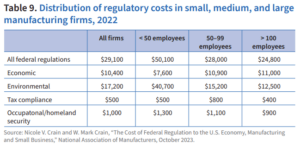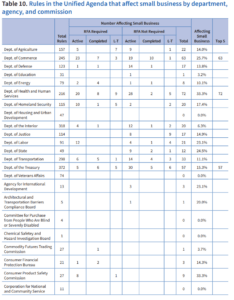Chapter 8: Federal regulations affecting small business
The aforementioned National Association of Manufacturers (NAM) report found that average annual per-employee regulatory costs to firms vary by firm size. The smaller the firm, the larger the per-employee regulatory costs, particularly in manufacturing. As shown in Table 9, the NAM found that per-employee regulatory costs for firms with fewer than 50 workers can be far greater than those for larger firms—$50,100 for smaller firms, compared with $24,800 for larger ones.


business
The Regulatory Flexibility Act (RFA) directs federal agencies to consider their rules’ effects on small entities. Figure 21 depicts rules in active, completed, and long-term stages in the fall Unified Agenda that require RFA analysis, as well as rules that presumably do not rise to the level of requiring RFA scrutiny but that agencies still believe will affect small businesses. Of the 647 rules affecting small business in 2024, 320 required an RFA, down from 370 in 2023. Obama tallies were higher, occasionally exceeding 800. The count fell to 590 in 2017 in the Trump administration.
Here are averages of the number of rules requiring RFA analysis in fall Unified Agenda snapshots of completed, active, and long-term rules during recent administrations:
- George W. Bush: average of 377 rules requiring small-business RFA.
- Barack Obama: average of 406 rules.
- Donald Trump: average of 341 rules (included dozens deemed deregulatory).
- Joe Biden: average of 348 rules.
Table 10 breaks out the fall 2024 Unified Agenda’s 647 rules affecting small business by department, agency, and commission. The top five—the FCC; the Departments of Health and Human Services, Commerce, and the Treasury; and the multiagency Federal Acquisition Regulation system—are the standouts, accounting for 339 rules, or 52 percent of the 647 rules affecting small business.
The FCC alone contributes 94 long-term rules deemed to require RFA analysis (up from 80 the prior year). The overall proportion of total rules affecting small business in the Unified Agenda stands at 19 percent but varies widely among agencies. Of the 647 rules affecting small business, 76 are deemed Section 3(f)(1) Significant (compared to 105 the prior year). These are broken out at the bottom of Table 10. Dips in major rulemaking are common in election years.

To complement the fall Unified Agenda snapshots, we return for a moment to the Federal Register and its calendar-year depictions of finalized small-business rules. Figure 22 depicts the larger universe of final rules and the “significant” subset completed in the Federal Register deemed to affect small business since 2015. Overall counts stand above pre-Trump levels, whereas at the moment the significant subset stands below Obama heights. However, again, Biden’s Section 3(f)(1) criteria leaves out rules costing between $100 million and $200 million. The 2024 Federal Register contains 76 significant final small–business rules among the total of 770, which might be compared with the 14 completed small-business rules in the fall Unified Agenda recognized as S3F1 Significant (bottom of Table 10).




With the transition-year overlap caveat once again in mind, here are calendar-year averages of the number of final and final significant rules in the Federal Register affecting small business during recent administrations:
- Barack Obama (eight years): average 694 rules per year affecting small business, 117 significant.
- Donald Trump (four years): average 701 rules per year affecting small business, 70 significant (including deregulatory).
- Joe Biden (four years): average 846 rules per year, 82 significant.
Just Biden had higher averages than Trump and Obama for total final rules affecting small business, he was doing the same for total proposed rules in the Federal Register affecting small business, despite dropping to 548 in 2024. This category recently peaked at 823 in 2021, as seen in Figure 23. Counts for proposed rules deemed to affect small business classified as significant are considerably lower, however.

Transition caveat in mind yet again, here are calendar-year averages of the number of proposed and significant proposed rules affecting small business during recent administrations:
- Barack Obama (eight years): average 612 proposed rules per year affecting small business, 128 significant.
- Donald Trump (four years): average 572 proposed rules per year, 72 significant (includes deregulatory).
- Joe Biden (four years): average 711 rules per year, 66 significant.
The legislative foundations of regulations affecting small business are without doubt substantial. Appendix K presents a partial list of non-sector-specific laws whose regulations affect growing businesses.
